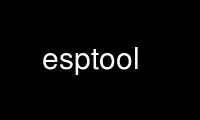
This is the command esptool that can be run in the OnWorks free hosting provider using one of our multiple free online workstations such as Ubuntu Online, Fedora Online, Windows online emulator or MAC OS online emulator
PROGRAM:
NAME
esptool - create and flash firmware files to ESP8266 or ESP32 chips
SYNOPSIS
esptool [FLASH OPTION]...
esptool [CREATION OPTION]...
DESCRIPTION
Flash firmware files to ESP8266 or ESP32 boards with ability to automatically put certain
boards into UART bootloader programming mode. Or, extract code sections from ELF
executable files to create firmware files for ESP chips.
OPTIONS
Flash:
-cp <device>
Select a serial port device to communicate with an ESP chip. Default is
/dev/ttyUSB0 on Linux, COM1 on Windows and /dev/tty.usbserial on Mac OS X.
-cb <baudrate>
Select the baud rate. Default is 115200.
-ca <address>
Flash memory address to upload the data to. Default is 0x00000000.
-cf <filename>
Upload the file to flash memory. Serial communication parameters and flash memory
address must precede this argument.
-cp <size>
Pad last written section to the given size, in bytes.
-cc <chip>
Select chip to upload to. Currently supported values are: esp8266 (default), esp32.
-cd <board>
Reset board into bootloader mode. Default is none.
Resetting methods:
nodemcu
GPIO0 and RESET are controlled by two NPN transistors as implemented in NodeMCU
devkit.
wifio TXD controls GPIO0 via a PNP transistor, while DTR controls RESET via a capacitor.
ck RTS controls RESET or CH_PD, while DTR controls GPIO0;
none No DTR/RTS manipulation.
Firmware creation:
-eo <filename>
Open an ELF object file, parse it and cache information found therein. Only one
input file could be opened at a time.
-es <section> <filename>
Read the given section from currently opened input file and make raw dump into the
specified file.
-ec Close the currently opened input file.
-bo <filename>
Prepare a new firmware image file for writing.
-bm <qio|qout|dio|dout>
Set the flash chip interface mode. Default is QIO. This parameter is stored in the
firmware image header along with the flash size and flash frequency. ROM bootloader
in the ESP chip uses this info to know how to talk to the flash memory chip.
-bz <512K|256K|1M|2M|4M|8M|16M|32M>
Set the flash chip size. Default is 512K.
-bf <40|26|20|80>
Set the flash chip frequency in MHz. Default is 40M.
-bs <section>
Read the specified section from the input file and append it to the firmware image.
The sections will appear in the same order as the -bs options appear on the command
line.
-bc Flush the content into the firmware image and close the file.
Other:
-v Display verbose informational messages. Add more v's to increase verbosity level,
e.g. -vv, -vvv.
-q Suppress informational messages.
--help Display help.
--version
Display program version information.
EXAMPLES
Flash Lua script firmware to a NodeMCU board:
esptool -cd nodemcu -cf nodemcu_integer_0.9.5_20150318.bin
Flash MicroPython for ESP8266 firmware to a Huzzah or EzSBC ESP board: First reset the
board into flash programming mode. Holod GPIO0/Flash button and press reset button,
release the reset button and finally release the GPIO0/Flash button. Then run the
following command:
esptool -cf firmware-combined.bin
Flash Espressif AT v0.50 firmware to an ESP board: First manually reset the board into
flash programming mode or use correct -cd option, then run:
esptool -ca 0x00000 -cf noboot/eagle.flash.bin -ca 0x40000 -cf
noboot/eagle.irom0text.bin -ca 0x3e000 -cf blank.bin -ca 0x7c000 -cf
esp_init_data_default.bin -ca 0x7E000 -cf blank.bin
Create firmware files from app.elf. Note the option for 4M flash size.
esptool -bz 4M -eo app.elf -bo app_00000.bin -bs .text -bs .data -bs .rodata -bc
-ec -eo app.elf -es .irom0.text app_40000.bin -ec
Then, flash the created firmware to the board:
esptool -cf 00000.bin -ca 0x40000 -cf 40000.bin
Use esptool online using onworks.net services
